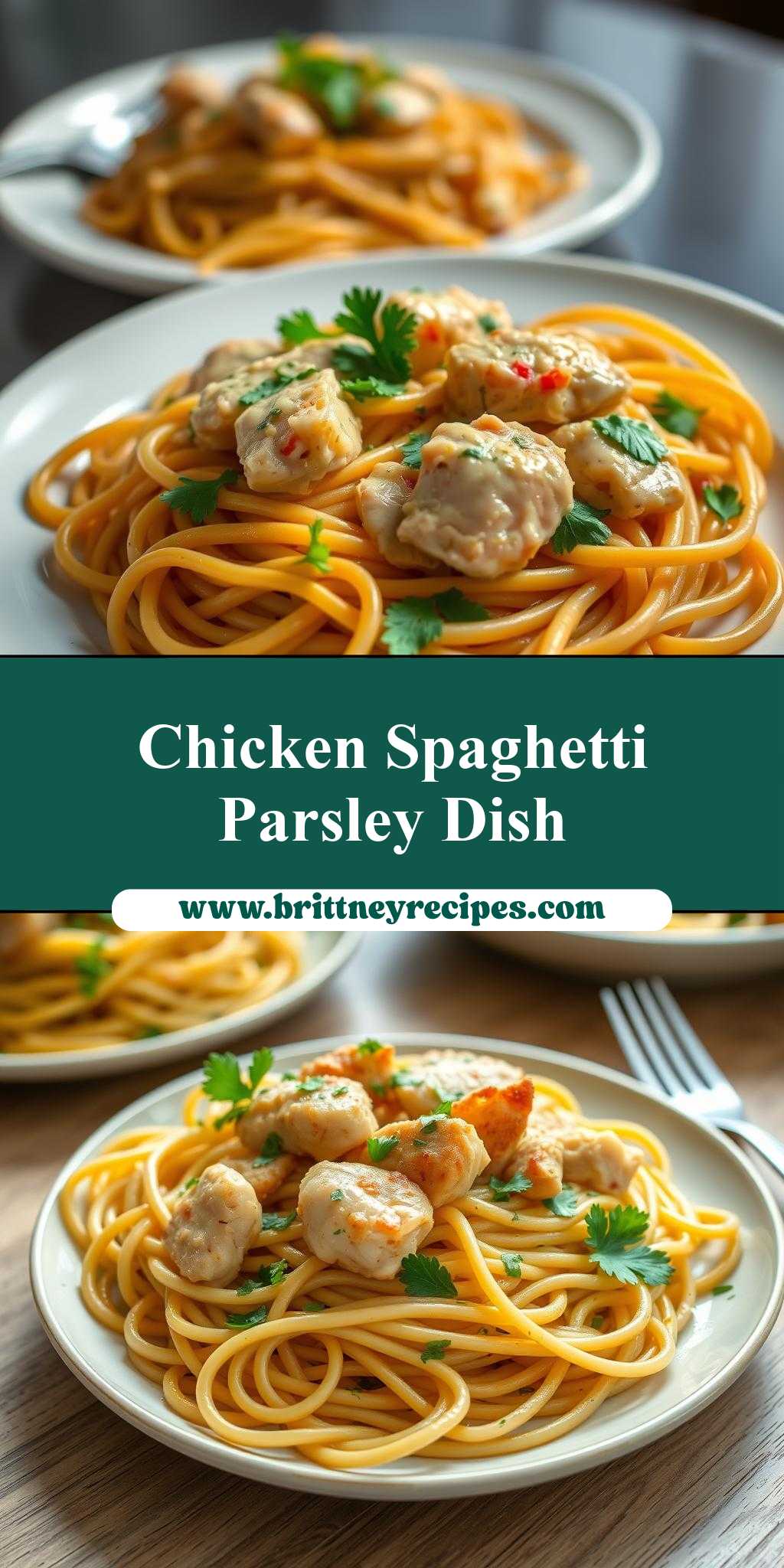What makes the perfect weeknight dinner? A homemade plate of spaghetti with chicken, loaded with fresh parsley and cooked to perfection in a quick and easy sauce. Plus, it’s a family favorite that’s ready in no time. Save this idea for a delicious homemade meal Pin for later
two plates of spaghetti with chicken and parsley
Introduction
Imagine a dish so divine, it combines the simplicity of everyday ingredients with the elegance of a fine dining experience. Welcome to the world of spaghetti with chicken and parsley, a culinary masterpiece that will leave your taste buds dancing with joy. This recipe is not just about feeding your family; it’s about creating memories around the dinner table. With its perfect balance of flavors, ease of preparation, and the versatility to adapt to any palate, this dish is sure to become a staple in your kitchen. So, let’s dive into the magic of creating two plates of spaghetti with chicken and parsley that will impress even the most discerning foodies.
Why This Works
- Flavor balance and ingredient accessibility: The combination of juicy chicken, fresh parsley, and perfectly cooked spaghetti creates a harmony of flavors that are both accessible and delicious.
- Ease of preparation: This recipe is a testament to simplicity, requiring minimal effort for maximum flavor, making it perfect for a quick dinner or a special occasion.
- Impressive results with minimal effort: The presentation and taste of this dish are deceptively elegant, considering how straightforward it is to prepare, making it an ideal choice for entertaining guests.
Key Ingredients
The magic of this recipe lies in its ingredients. You’ll need 1 pound of spaghetti, 2 boneless, skinless chicken breasts, 1/4 cup of olive oil, 4 cloves of garlic minced, 1 cup of fresh parsley chopped, 1 teaspoon of dried basil, salt, and pepper to taste, and 1 cup of grated Parmesan cheese. For practical substitutions, you can use different types of pasta, swap chicken with shrimp or tofu for a vegetarian option, and play with various herbs like basil or oregano to give it your personal touch.
Instructions
- Step 1: Begin by preparing your ingredients. Chop the parsley, mince the garlic, and season the chicken with salt, pepper, and basil. Bring a large pot of salted water to a boil and cook the spaghetti according to the package instructions until it’s al dente. Reserve 1 cup of pasta water before draining the spaghetti.
- Step 2: In a large skillet, heat the olive oil over medium-high heat. Add the chicken and cook until browned on both sides and cooked through, about 5-6 minutes per side. Remove the chicken from the skillet and set it aside to rest.
- Step 3: In the same skillet, add the minced garlic and cook for 1 minute until fragrant. Then, add the chopped parsley and cook for another minute, stirring constantly to prevent burning. Add the reserved pasta water to the skillet and stir to combine, creating a light sauce that will coat your spaghetti perfectly.
- Step 4: Slice the rested chicken into thin strips. Add the cooked spaghetti to the skillet, tossing it with the parsley and garlic sauce. If the sauce seems too thick, add a bit more pasta water. Finally, add the sliced chicken back into the skillet and toss everything together, ensuring the chicken is well coated with the sauce and the spaghetti is evenly distributed.
Handy Tips
- Always use high-quality ingredients, especially the parsley and Parmesan cheese, as they greatly impact the flavor of the dish.
- Don’t overcook the spaghetti; al dente is key to maintaining texture and preventing the pasta from becoming mushy.
- Experiment with different seasonings on the chicken, like paprika or lemon zest, to add unique flavors to the dish.
Heat Control
Heat control is crucial in this recipe, especially when cooking the chicken and the garlic. For the chicken, medium-high heat is ideal for achieving a nice brown on the outside while keeping the inside juicy. When cooking the garlic, reduce the heat to medium to prevent burning, as garlic can quickly go from perfectly toasted to burnt.
Crunch Factor
The crunch factor in this dish comes from the freshness of the parsley and the slight crunch of the al dente spaghetti. To maintain this texture, avoid overcooking the spaghetti and use fresh parsley instead of dried. If you want to add more crunch, consider sprinkling some toasted pine nuts or almonds on top of the dish before serving.
Pro Kitchen Tricks
- Use a cast-iron skillet for cooking the chicken and making the sauce, as it retains heat well and can go from stovetop to oven if needed.
- Don’t overcrowd the skillet when cooking the chicken; cook in batches if necessary, to ensure each piece has enough room to cook evenly.
- Keep your ingredients ready and within reach, a technique known as “mise en place,” to make the cooking process smoother and less stressful.
Storage Tips
- Leftovers can be stored in an airtight container in the refrigerator for up to 3 days. Reheat gently in the microwave or on the stovetop, adding a bit of water if the sauce has thickened.
- For longer storage, consider freezing the cooked spaghetti and chicken separately, then combining and reheating when needed. Frozen dishes can last for up to 3 months.
- When reheating, always check the temperature to ensure the chicken is heated to a safe internal temperature of 165°F (74°C).
Gift Packaging Ideas
This dish might be more challenging to gift due to its perishable nature, but if you’re looking to share, consider packaging the components separately. Cook the spaghetti and chicken, then let them cool. Package each component in microwave-safe containers, and include a small bag of fresh parsley and a wedge of Parmesan cheese. The recipient can then combine and reheat the dish at their convenience, enjoying the freshness and flavor of your culinary creation.
Flavor Variations
- Different spices: Try adding a pinch of red pepper flakes for a spicy kick or some dried oregano for an Italian twist.
- Creative toppings: In addition to parsley, consider topping your spaghetti with toasted breadcrumbs, grated carrot, or even a fried egg for added richness.
- Ingredient swaps: Swap the chicken with shrimp for a seafood version, or use roasted vegetables like zucchini or bell peppers for a vegetarian option.
Troubleshooting
- Texture problems: If your spaghetti is too mushy, it was overcooked. For a better texture, try cooking it for less time. If the chicken is dry, it might have been overcooked or not rested properly after cooking.
- Ingredient replacements: If you don’t have parsley, basil or dill can be used as substitutes. For chicken, you can use turkey or pork as alternatives.
- Over/undercooking signs: Chicken is cooked through when it reaches an internal temperature of 165°F (74°C). Spaghetti is al dente when it still has a bit of bite or chew to it.
FAQs
- Can I freeze it? Yes, you can freeze the cooked spaghetti and chicken separately for up to 3 months. Reheat and combine when needed.
- Is it gluten-free? Traditional spaghetti is not gluten-free, but you can substitute it with gluten-free pasta made from rice, quinoa, or corn.
- Can I double the recipe? Absolutely, this recipe can be easily doubled or tripled for larger gatherings. Just ensure you have enough pots and skillets to accommodate the increased quantity.
Conclusion
As we conclude this culinary journey through the simplicity and elegance of spaghetti with chicken and parsley, remember that the true beauty of cooking lies not just in the ingredients or the techniques, but in the joy of sharing and the love that goes into every dish. Whether you’re a seasoned chef or a beginner in the kitchen, this recipe is a versatile canvas waiting for your personal touch. So, don’t be afraid to experiment, to try new flavors, and to make this dish your own. Happy cooking, and buon appetito!

